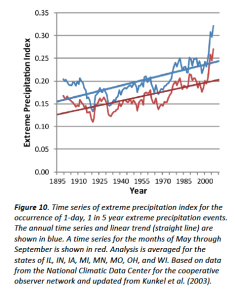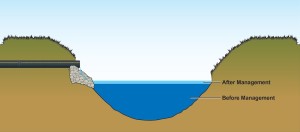What is the role of subsurface water management in flooding?
July 26, 2013
 By Eric Stearns, Agricultural Conservation Engineer, Prinsco
By Eric Stearns, Agricultural Conservation Engineer, Prinsco
The cause of flooding in our Midwestern states has been a topic of much discussion in recent years. While it is easy to point fingers at agricultural water management systems, and there’s no doubt they play a role, they are certainly not the driver of our overall flooding increases. In fact, in some cases subsurface water management systems can actually mitigate flooding factors.
Here are some key points to consider:

Found at http://glisa.msu.edu/docs/NCA/MTIT_Historical.pdf
Normal precipitation levels are on the rise.
Normal precipitation levels in Minnesota, for example, are carefully measured and recorded by the Minnesota State Climatology Office. According to their data1, the Minnesota River Basin experienced an average annual precipitation from 1971-2000 of 22-31 inches. Between 1981-2010, that average rose over 2 inches to 24-33 inches! While 2 inches doesn’t sound like much, it can have an extremely significant impact on the overall flow of a waterway like the Minnesota River. If I were to make a conservative estimate of just 1/3 of that water reaching the Minnesota River, it could add over 194 billion gallons of water and cause much higher than normal river level fluctuations.
The intensity of weather events is on the rise.
There’s little doubt that changing weather patterns and the recurrence of extreme weather events have contributed to an increase in flooding. A report2 by the Great Lakes Integrated Sciences & Assessments titled, Historical Climate and Climate Trends in the Midwestern US, says, “Over the region as a whole, the occurrence of intense precipitation events has risen substantially in recent decades.” The chart to the right demonstrates the increase.
Increased rainfall intensity creates situations where soil is unable to take in all of the precipitation that is falling. This is where catastrophic flooding occurs because with or without subsurface water management, the soil is unable to infiltrate all of the rainfall. Therefore, when rain falls at a high intensity, overland flow will be produced causing catastrophic flooding events.
The contribution of agricultural drainage to water volume is fairly minimal in proportion to other factors.
Relative to the contribution of average precipitation increases, extreme weather events, municipal/industrial water discharge, and land use changes from rural to urban, the volume added to waterways by agricultural subsurface water management systems is fairly minimal. Flow out of a management system would increase normal water levels in an average stream by 5-10%, which translates to just a couple inches, illustrated by the chart to the right.
A well-designed subsurface water management system can decrease peak flow rates, reduce surface runoff and improve water quality. Let me explain:When moderate rains fall on a saturated, non-managed field, much of the peak flow moves over the land’s surface and directly into a stream or ditch. This is called surface runoff, and is typically filled with suspended soil and chemicals that can be deposited into waterways as pollutants.
In comparison, when moderate rains fall on managed fields, water is encouraged to move downward through the soil profile, which slows it down leaving soil particles and chemicals in place. Subsurface water management systems ensure that only water which is beyond the field’s capacity to use is carried away and released into the waterways. In addition, these systems are designed to release water at a controlled rate, which mitigates the peak flow rates caused by intense rainfall.
Get the facts.
When reading articles or hearing discussions related to agricultural water management practices, be sure to get all the facts. We find that our industry is often misunderstood, which has caused a fair amount of confusion and misleading information to be referenced in the media lately.
At Prinsco, we make it easy to learn more. Just go to www.Prinsco.com/Education for all the resources you need.
1
Minnesota State Climatology Office. Minnesota Climatology Working Group. University of Minnesota, 2012. www.climate.umn.edu.
2
Categories: Agriculture

